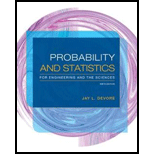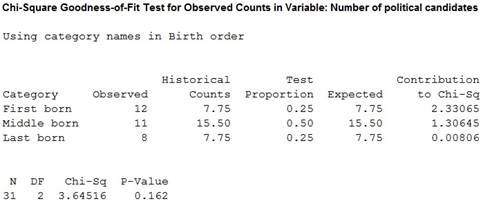
Concept explainers
The article “Birth Order and Political Success” (Psych. Reports, 1971: 1239–1242) reports that among 31 randomly selected candidates for political office who came from families with four children, 12 were firstborn, 11 were middle born, and 8 were last born. Use this data to test the null hypothesis that a political candidate from such a family is equally likely to be in any one of the four ordinal positions.
Test the null hypothesis that the political candidate from a family with four children is equally likely within one of the four positions.
Answer to Problem 37SE
There is sufficient evidence to conclude that political candidate from a family with four children is equally likely within one of the four positions.
Explanation of Solution
Given info:
A study conducted with 31 political candidates states the 12 candidates were firstborn, 11 candidates were middle born and 8 candidates were last born.
Calculation:
The claim is to test whether the political candidate from a family with four children is equally likely within one of the four positions. If the claim is rejected, then the political candidate from a family with four children is not equally likely within one of the four positions.
A family with four children has first, second, third and fourth child. For an equally likely event the probability would be
Testing the hypothesis:
Null hypothesis:
That is, the political candidate in a four children family is equally likely to occur.
Alternative hypothesis:
That is, the observed proportion for at least one category is not equal to the expected proportion.
Expected frequency:
The expected frequency for each group is calculated as follows,
Where,
n is the total number of observed frequency.
The expected frequency for the first category:
The expected frequency for the second category:
The expected frequency for the third category:
Test statistic:
Software procedure:
Step-by-step procedure to obtain the test statistic using MINITAB is given below:
- Choose Stat > Tables > Chi-Square Goodness-of-Fit Test (One Variable).
- In Observed counts, enter the column of Number of political candidates.
- In Category names, enter the column of Birth order.
- Under Test, select the column of Expected frequency in Proportions specified by historical counts.
- Click OK.
Output obtained from MINITAB is given below:

Decision rule:
If
If
Conclusion:
The P-value is 0.162 and the level of significance is 0.10.
The P-value is greater than the level of significance.
That is,
Hence, the null hypothesis is not rejected.
Thus, there is sufficient evidence to conclude that the political candidate from a family with four children is equally likely within one of the four positions.
Want to see more full solutions like this?
Chapter 14 Solutions
Bundle: Probability and Statistics for Engineering and the Sciences, 9th + WebAssign Printed Access Card for Devore's Probability and Statistics for ... and the Sciences, 9th Edition, Single-Term
- F Make a box plot from the five-number summary: 100, 105, 120, 135, 140. harrow_forward14 Is the standard deviation affected by skewed data? If so, how? foldarrow_forwardFrequency 15 Suppose that your friend believes his gambling partner plays with a loaded die (not fair). He shows you a graph of the outcomes of the games played with this die (see the following figure). Based on this graph, do you agree with this person? Why or why not? 65 Single Die Outcomes: Graph 1 60 55 50 45 40 1 2 3 4 Outcome 55 6arrow_forward
- lie y H 16 The first month's telephone bills for new customers of a certain phone company are shown in the following figure. The histogram showing the bills is misleading, however. Explain why, and suggest a solution. Frequency 140 120 100 80 60 40 20 0 0 20 40 60 80 Telephone Bill ($) 100 120arrow_forward25 ptical rule applies because t Does the empirical rule apply to the data set shown in the following figure? Explain. 2 6 5 Frequency 3 сл 2 1 0 2 4 6 8 00arrow_forward24 Line graphs typically connect the dots that represent the data values over time. If the time increments between the dots are large, explain why the line graph can be somewhat misleading.arrow_forward
- 17 Make a box plot from the five-number summary: 3, 4, 7, 16, 17. 992) waarrow_forward12 10 - 8 6 4 29 0 Interpret the shape, center and spread of the following box plot. brill smo slob.nl bagharrow_forwardSuppose that a driver's test has a mean score of 7 (out of 10 points) and standard deviation 0.5. a. Explain why you can reasonably assume that the data set of the test scores is mound-shaped. b. For the drivers taking this particular test, where should 68 percent of them score? c. Where should 95 percent of them score? d. Where should 99.7 percent of them score? Sarrow_forward
- 13 Can the mean of a data set be higher than most of the values in the set? If so, how? Can the median of a set be higher than most of the values? If so, how? srit to estaarrow_forwardA random variable X takes values 0 and 1 with probabilities q and p, respectively, with q+p=1. find the moment generating function of X and show that all the moments about the origin equal p. (Note- Please include as much detailed solution/steps in the solution to understand, Thank you!)arrow_forward1 (Expected Shortfall) Suppose the price of an asset Pt follows a normal random walk, i.e., Pt = Po+r₁ + ... + rt with r₁, r2,... being IID N(μ, o²). Po+r1+. ⚫ Suppose the VaR of rt is VaRq(rt) at level q, find the VaR of the price in T days, i.e., VaRq(Pt – Pt–T). - • If ESq(rt) = A, find ES₁(Pt – Pt–T).arrow_forward
 Holt Mcdougal Larson Pre-algebra: Student Edition...AlgebraISBN:9780547587776Author:HOLT MCDOUGALPublisher:HOLT MCDOUGAL
Holt Mcdougal Larson Pre-algebra: Student Edition...AlgebraISBN:9780547587776Author:HOLT MCDOUGALPublisher:HOLT MCDOUGAL College Algebra (MindTap Course List)AlgebraISBN:9781305652231Author:R. David Gustafson, Jeff HughesPublisher:Cengage Learning
College Algebra (MindTap Course List)AlgebraISBN:9781305652231Author:R. David Gustafson, Jeff HughesPublisher:Cengage Learning
 Algebra & Trigonometry with Analytic GeometryAlgebraISBN:9781133382119Author:SwokowskiPublisher:Cengage
Algebra & Trigonometry with Analytic GeometryAlgebraISBN:9781133382119Author:SwokowskiPublisher:Cengage




